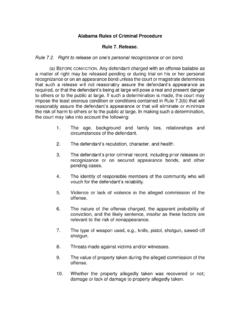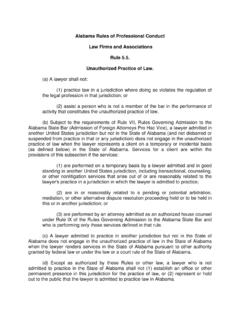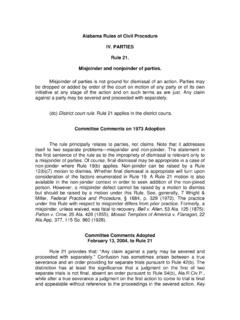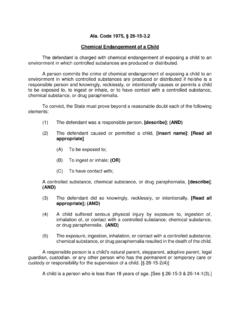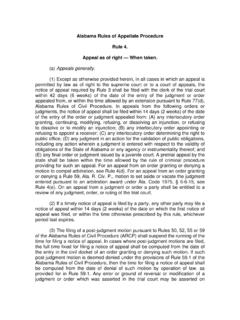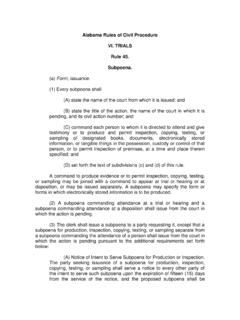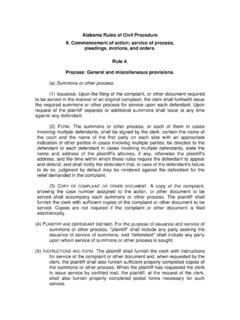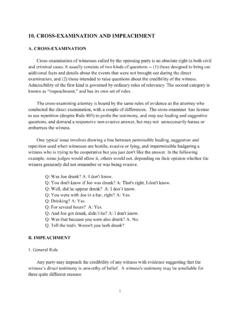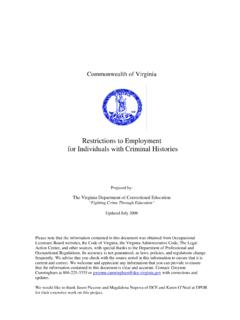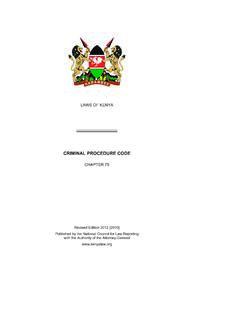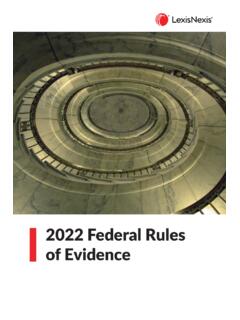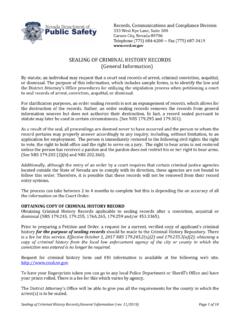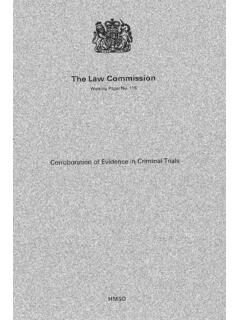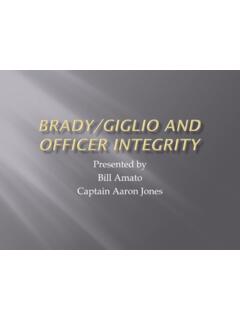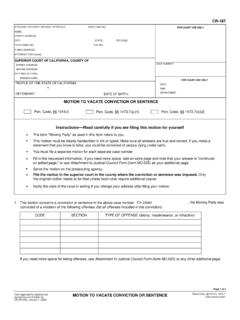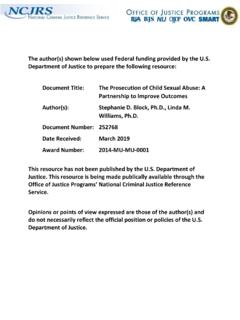Transcription of Alabama Rules of Criminal Procedure Rule 7. Release.
1 Alabama Rules of Criminal Procedure Rule 7. Release. Rule Right to release on one s personal recognizance or on bond. (a) BEFORE conviction . Any defendant charged with an offense bailable as a matter of right may be released pending or during trial on his or her personal recognizance or on an appearance bond unless the court or magistrate determines that such a release will not reasonably assure the defendant s appearance as required, or that the defendant s being at large will pose a real and present danger to others or to the public at large. If such a determination is made, the court may impose the least onerous condition or conditions contained in Rule (b) that will reasonably assure the defendant s appearance or that will eliminate or minimize the risk of harm to others or to the public at large.
2 In making such a determination, the court may take into account the following: 1. The age, background and family ties, relationships and circumstances of the defendant. 2. The defendant s reputation, character, and health. 3. The defendant s prior Criminal record, including prior releases on recognizance or on secured appearance bonds, and other pending cases. 4. The identity of responsible members of the community who will vouch for the defendant s reliability. 5. Violence or lack of violence in the alleged commission of the offense. 6. The nature of the offense charged, the apparent probability of conviction , and the likely sentence, insofar as these factors are relevant to the risk of nonappearance.
3 7. The type of weapon used, , knife, pistol, shotgun, sawed-off shotgun. 8. Threats made against victims and/or witnesses. 9. The value of property taken during the alleged commission of the offense. 10. Whether the property allegedly taken was recovered or not; damage or lack of damage to property allegedly taken. 11. Residence of the defendant, including consideration of real property ownership, and length of residence in his or her place of domicile. 12. In cases where the defendant is charged with a drug offense, evidence of selling or pusher activity should indicate a substantial increase in the amount of bond. 13. Consideration of the defendant s employment status and history, the location of defendant s employment, , whether employed in the county where the alleged offense occurred, and the defendant s financial condition.
4 14. Any enhancement statutes related to the charged offense. (b) BAIL SCHEDULE. The following schedule is established as a general rule for circuit, district and municipal courts in setting bail for persons charged with bailable offenses. Except where release is required in the minimum schedule amount pursuant to the Rules of Criminal Procedure , courts should exercise discretion in setting bail above or below the scheduled amounts. BAIL SCHEDULE Recommended Range Felonies: Capital felony $50,000 to No Bail Allowed Murder $15,000 to $ 150,000 Class A felony $10,000 to $ 60,000 Class B felony $ 5,000 to $ 30,000 Class C felony $ 2,500 to $ 15,000 Drug manufacturing and trafficking $ 5,000 to $1,500,000 Class D felony $1,000 to $ 10,000 Misdemeanors (not included elsewhere in the schedule): Class A misdemeanor $ 300 to $ 6,000 Class B misdemeanor $ 300* to $ 3,000 Class C misdemeanor $ 300 to $ 1,000 Violation $ 300 to $ 500 Municipal Ordinance Violations $ 300 to $ 1,000 Traffic-Related Offenses.
5 DUI $ 1,000 to $ 7,500 Reckless driving $ 300 to $ 1,000 Speeding $ 300 to $ 500 Other traffic violations $ 300 to $ 500 *$300 was set as the lower limit in compliance with Ala. Code 1975, 15-13-105, providing that "in violation and misdemeanor cases the minimum amount of bail shall be $300 for each offense charged. (c) AFTER conviction AND SENTENCING. (1) A defendant who has been convicted of an offense and who for that offense has been sentenced to punishment by death, by life imprisonment, or by imprisonment for a term in excess of twenty (20) years, shall not be released. (2) Any defendant who has been convicted of an offense for which the defendant has been sentenced to a term of imprisonment for twenty (20) years or less may be released on a secured appearance bond or on the defendant s personal recognizance, (i) Upon application for release made concurrently with the filing of a notice of appeal, or (ii) If the application for probation is made, upon application for release made at any time before probation has been granted or denied.
6 (d) DENIAL OF RELEASE. Release shall be denied after conviction and sentencing if the trial court has reason to believe that an appearance bond or conditions of release will not reasonably assure that the defendant will not flee, or that the defendant s being at large poses a real and present danger of harm to any other person or to the public at large, or if at the time the sentence was rendered, the defendant filed a notice of appeal and elected to waive release and to begin serving the sentence. [Amended 11-30-93, eff 4-1-95; Amended eff. 5-17-95; Amended eff. 8-1-97; Amended 6-21-2007, eff 9-1-2007; Amended 11-22-2016. eff. 1-1-2017.] Committee Comments The Eighth Amendment to the United States Constitution provides: Excessive bail shall not be required, nor excessive fines imposed, nor cruel and unusual punishments inflicted.
7 Art. 1, 16, Alabama Constitution of 1901, provides: That all persons shall, before conviction , be bailable by sufficient sureties, except for capital offenses, when the proof is evident or the presumption great; and that excessive bail shall not in any case be required. See also 1975, 15-13-2, and -3, for right to bail as a matter of right. Assuming that the offense is bailable, Rule is based on the presumption of innocence of the accused and the policy that a defendant should be released pending trial whenever possible. The defendant is eligible for a recognizance release unless the judge determines that the defendant s presence would not thereby be reasonably assured or that the defendant poses a real and present danger of harm to others.
8 The list of factors to be considered is taken from the ABA, Standards for Criminal Justice, Pretrial Release (2d ed. 1986). Section (b) recognizes that after conviction the defendant is no longer presumed innocent and is not entitled admission to bail as a matter of right. If the defendant s sentence is for twenty (20) years or less, he can be admitted to bail, in the judge s discretion, unless the judge has reason to believe that bail will not reasonably assure that the defendant will not flee, or that there is a real and present danger to others posed by the defendant s being at large, thereby modifying 1975, 12-22-170, which unconditionally allows bail if the sentence does not exceed twenty (20) years. Under Rule (b)(2)(i), a convicted defendant may apply for release on an appearance bond or on his personal recognizance at the time of filing a notice of appeal.
9 This changes former practice whereby application for release had to be made with the filing of notice of appeal at the time sentence was rendered ( , at the time sentence was pronounced), an unduly restrictive, unfair, and technical trap for the unwary practitioner. See Ex parte Downer, 44 77, 203 132 (1967); Ex parte Rogers, 53 245, 298 665 (1974); Ex parte Pennington, 57 128, 326 656 (1976). For Appeal as of Right When Taken, see , Rule 4(b). Cf. , Rule 46(c). Rule (b)(2) allows some discretion to the trial judge in releasing the defendant on bail or on the defendant s personal recognizance. If the defendant has initially filed a notice of appeal at the time sentence was pronounced but elected to waive release and to begin serving the sentence, and thereafter requests that the sentence be suspended, whether to grant bail is left to the discretion of the trial court.
10 There are no cases on this point, and there has been some question whether the trial court retains jurisdiction over the defendant, because the defendant will have already begun serving sentence. However, it is preferable that the trial court make the release decision, because that court is more familiar with the case, because the record is usually still with the trial court, and because any witnesses would be more readily available to that court. Rule (b)(2) conforms with the Alabama Rules of Appellate Procedure . Rule 9(b) of the appellate Rules provides: Release after judgment of conviction shall be governed by Title 15, 368 and 372 [ 1975, 12-22-170]. Committee Comments to Amendment to Rule Effective April 1, 1995 Rule (a) applies to pretrial release and is based on the presumption of innocence of the accused and the constitutional and statutory right of a defendant charged with a noncapital offense to be released on bail pending trial.
